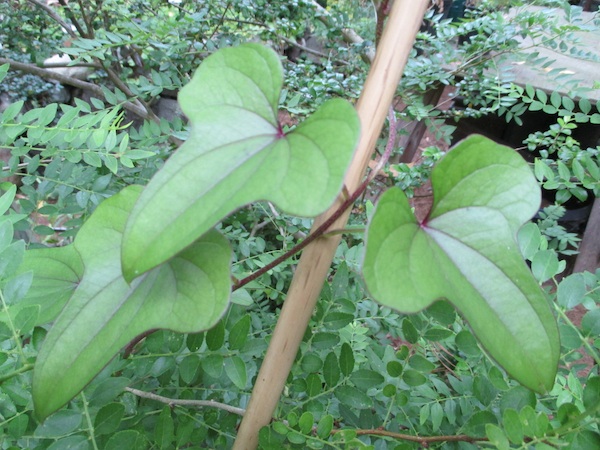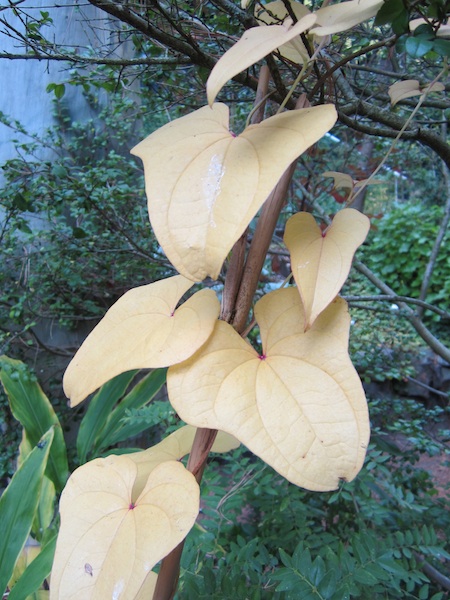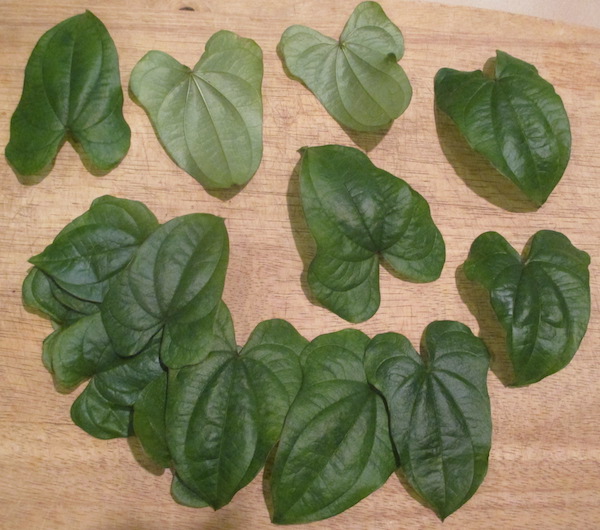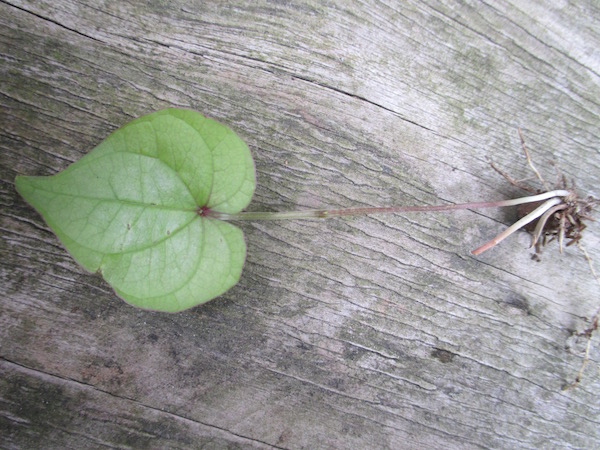| Of over 600 species of Dioscorea widely growing around the planet, at least 132 have been reported as having their tubers or aerial tubers (bulbils) eaten by people. The common English name of these tubers is yam. In the United States, the name yam is often also used for kinds of sweet potatoes, as explained in my plant-of-the-month article of November 2010. |
| Most Dioscorea are tropical, or at least grow in warm-temperate areas. The species produce perennial tuberous roots (earthnuts); their vining stems with leaves can be annual, biennial, or perennial; some grow enormous. Most produce flowers and fruit; a few chiefly or only produce aerial bulbs called bulbils. Most have a distinct dormant season. |
| The Dioscorea genus is important to people for both medicine and food. Its role in ornamental horticulture, such as for houseplant or greenhouse usage, is minimal. |
Below, I list 7 kinds well known for edible tubers, followed by the only 7 kinds that I found reported for edible greenery or flowers. (in February 2014, I found three articles in French, cited below, that add species whose greens have been eaten: D. alata L. young leaves; D. Baya De Wild. leaves; D. Burkilliana J. Miège leaves; D. cayennensis Lam. leaves; D. Mangenotiana J. Miège young stems; D. præhensilis Benth. seedlings and young parts of stems; D. Preussii Pax edible stem & leaves but tubers are toxic. For details, consult: 1) Les Dioscoreaceae du Congo by Jean S. N'Kounkou in Fragmenta Floristica et Geobotanica. Suppl. 2(1): 139-182. 1993 ; 2) L'homme et l'igname au Congo by J.S. N'Kounkou in The Biodiversity of African Plants 1996; 3) Végétation et plantes alimentaires de la région de la Sangha (Nord-Congo) by J.M. Moutsamboté in The Biodiversity of African Plants 1996.
In December 2014, I found that in southern Bhutan, the young leaves and buds of D. bulbifera are used as a vegetable (Wild plants as Non Wood Forest Products used by the rural community of Dagana, a
southern foothill district of Bhutan by Prabhat Kumar Mukhia.) June 2013.
|
| It is vital to emphasize that many Dioscorea species are toxic, at least uncooked; and some require very time consuming preparation before they can be eaten safely. Hence, many species are deemed second rate, or mere famine food. Even the best tubers are not as nutritious as sweet potatoes or regular potatoes, being mainly merely starch. |
| What piques my interest is: are any of the greens good tasting, nutritious, and are from species that can be cultivated indoors in a cold climate such as Seattle? As far as I know, no one has looked into this yet. I thrive on discovering little known --or unknown-- useful information to share with my readers. |
| The only species in the genus that I have grown in Seattle is called Cinnamon Vine, Chinese Yam or Potato. In U.S.A. cultivation, it is usually sold as Dioscorea Batatas, but is correctly Dioscorea polystachya, as noted below. I have grown it outside, and its leaves turn pale yellow in autumn, then die. |
I desire tubers or bulbils of other, cold-tender species, to test in pots indoors. But mail-order nurseries offer only very few kinds of Dioscorea species, so I must buy seeds, or obtain starts from non-commercial sources. If any readers can help, I shall be grateful.
In mid-September 2014, I went to an Asian market in Seattle, bought a D. polystachya yam, potted it, grew the vine as a houseplant, then on November 25th cooked and ate some leaves as shown in my photos.)
|
| Dioscorea alata L. |
| = D. aculeata Wight 1853, non L., Roxb. 1832, Balb. ex Kunth 1850 |
| = D. atropurpurea Roth. |
| = D. colocasiifolia Pax |
| = D. globosa Roth. |
| = D. purpurea Roth. |
| = D. rubella Roth. |
| = D. sativa Munro 1844, non Th. 1784, L. 1753, J. Presl 1827 |
| = D. vulgaris Miq. |
(Greater, Winged, Asiatic, Water, Ten-month, or White Yam) SE Asian; virtually unknown wild but the widest global distribution of yams; hundreds of cultivars. The vine stem is strongly 4-winged or angular. The aerial tubers are minor.
|
| Dioscorea bulbifera L. |
| = D. latifolia Benth. |
| = D. violacea Baudon 1913, non Uline 1896, R. Knuth 1917 |
(Air Potato. Aerial, Bitter, Otaheite, Potato or Yam. Bulb Yam. Cheeky Yam. Monkey Ball Vine. Old Man's Pecker Vine) Old World tropics; weedy in the far southern U.S.A. Its tubers are black and unimportant; the bulbils are the portions eaten, and only certain cultivars are good; some are bitter and toxic, at least uncooked.
|
| Dioscorea x cayennensis Lam. (non D. cayenensis Jum.) |
| = D. aculeata Balb. ex Kunth 1850, non L., Roxb. 1832, Wight 1853 |
(Yellow, Attoto, Negro, Twelve-month or Guinea Yam) The most important African yam; taken to U.S.A. during the slave trade. A cross of D. abyssinica. Other possible parents are D. Burkilliana, and D. præhensilis. The subspecies rotundata (Poir.) J. Miège = D. rotundata Poir. (Eight-month Yam or White Guinea-Yam) is grown on greater acreage that any other species, and has many cultivars.
|
| Dioscorea esculenta (Lour.) Burk. |
| = D. aculeata L. 1759, p.p., Roxb. 1832, non L. 1753, Balb. ex Kunth 1850, Wight 1853 |
| = D. sativa auct. |
| = D. fasiculata Roxb. |
| = D. spinosa Roxb. ex Wall. 1830, non Burm. 1769 |
| = D. papuana Warburg 1891, non Ridl. 1916 |
(Potato Yam. Lesser, Asiatic, Guinea, Fancy or Chinese Yam. Goa Potato) Native in N India, Burma, Thailand, Indochina, and New Guinea. The most widely cultivated species. Tuber light yellow, smooth, sweeter & more glutinous than that of D. alata.
|
| Dioscorea hispida Dennst. |
| = D. dæmona Roxb. |
| = D. mollissima Bl. |
| = D. hirsuta Roth 1821, Bl. 1827, non Mart. & Gal. 1842 |
| = D. triphylla Blanco 1837, non L. 1753, Buch.-Ham. ex Wall. 1831Ð32, Schimp. ex A. Rich. 1850 |
(Asiatic Bitter Yam. Intoxicating Yam) The chief famine food of tropical Asia. Tuber is poisonous due to alkaloid discorine quantity. Much time & skill required to slice, wash & boil to render it safe. According to Toxic Constituents of Some Indian Plants by N. Viswanathan & B.S. Joshi in Current Science vol. 52, Jan. 5, 1983: Tubers eaten only in times of scarcity. The country brew Khopadi prepared from the tubers has been the source of much tragedy. It causes burning of the mouth, nausea, vomiting, drowsiness, tachycardia, coma, respiratory depression and even death. The tuber is sometimes placed inside the carcasses of mauled animals to poison tigers.
|
| Dioscorea polystachya Turcz. |
| = D. Batatas Decne. |
| = D. Decaisneana Carr. |
| = D. opposita auct., non Th. |
(Chinese Yam or Potato. Cinnamon Vine) Native to E Asia, where cultivated for its edible tubers. In N America, planted as a garden ornamental, and has naturalized (mostly a male clone) in much of the eastern U.S.A. The tubers are said to grow as long as 3 feet. The stem can bear small axillary tubers late in the season. A Chinese cultivar "Prized for its exceptionally large and tasty tubers" is 'Wang Qu Sanyao' --trademarked as Dr Yao.
|
| Dioscorea trifida L. f. |
| = D. brasiliensis Willd. |
(Yampee or Yampi Yam. Indian Yam. Cush-cush) The only New World yam cultivated as a staple crop. Its tubers are relatively small. In Ecuador, its fruit is also cooked.
|
Above are seven yams grown for starch. Below are seven that also have reported greenery eaten.
|
| Dioscorea communis (L.) Cadd. & Wilkin 2002 |
| = Tamus communis L. |
| = Tamus edulis Lowe |
(Black or Edible Bryony. Lady's Seal. Oxberry) Young shoots are boiled around the Mediterranean.
|
| Dioscorea japonica Th. |
(Japanese Yam. Glutinous Yam) Closely related to D. polystachya. Tanaka's Cyclopedia of Edible Plants of the World 1976 by Tyozaburo Tanaka reports edible tubers, aerial bulbs, vines and leaves.
|
| Dioscorea mexicana Scheidw. |
| = D. macrostachya Benth. 1841, non Mart. & Gal. 1842 |
Huastec Mayan Ethnobotany by Janis B. Alcorn, 1984, reports the tuber cooked. Plants for Human Consumption 1984 by Günther Kunkel reports the leaves and shoots cooked in stews.
|
| Dioscorea pentaphylla L. 1753, non A. Rich. 1851 |
| = D. triphylla L. 1753, non Buch.-Ham. ex Wall. 1831Ð32, Blanco 1837, Schimp. ex A. Rich. 1850 |
(Fiveleaf, Sand, or Fibrous Yam) Many sources cite its tubers as edible cooked. But the male flowers and young leaves are also cooked.
|
| Dioscorea præhensilis Benth. |
| = D. odoratissima Pax |
| = D. Liebrechtsiana De Wild. & Dur. |
(Bush Yam) Widely consumed in W Africa; tubers, bulbils, young stems and leaves eaten in Congo & Ivory Coast. Some accounts call it bitter and mostly famine food.
|
| Dioscorea tenuipes Franch. & Sav. |
Native in China and Japan, both the tubers and young leaves are eaten.
|
| Dioscorea tomentosa J. Koenig ex Spreng. |
(Ooyala Yam, Thorny Yam) In India, the tuber is extensively boiled to render safe to eat. But also the young shoots and leaves are eaten as greens.
Back
|

Dioscorea polystachya leaves; photo by ALJ
|

Dioscorea polystachya fall color; photo by ALJ
|

Dioscorea polystachya green leaves in kitchen; photo by ALJ
|

Dioscorea polystachya growing from bulbil; photo by ALJ
|

